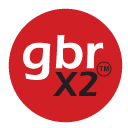 | |
| Filename extension |
.gbr |
|---|---|
| Internet media type |
application/vnd.gerber |
| Uniform Type Identifier (UTI) | com.ucamco.gerber.image |
| Developed by | Ucamco |
| Initial release | 27 August 1980 |
| Latest release | Revision 2023.08 30 August 2023 |
| Type of format | Image file format |
| Standard | Gerber Format Specification |
| Website | https://www.ucamco.com/en/gerber |
The Gerber format is an open, ASCII, vector format for printed circuit board (PCB) designs.[1] It is the de facto standard used by PCB industry software to describe the printed circuit board images: copper layers, solder mask, legend, drill data, etc.[2][3][4]
The standard file extension is .GBR or .gbr[1] though other extensions like .GB, .geb or .gerber are also used. It is documented by The Gerber Layer Format Specification and some related (but less universally supported) extensions such as XNC drill files and GerberJob to convey information about the entire PCB, as opposed to single layers.
Gerber is used in PCB fabrication data.[5] PCBs are designed on a specialized electronic design automation (EDA) or a computer-aided design (CAD) system.[6] The CAD systems output PCB fabrication data to allow fabrication of the board. This data typically contains a Gerber file for each image layer (copper layers, solder mask, legend or silk...). Gerber is also the standard image input format for all bare board fabrication equipment needing image data, such as photoplotters, legend printers, direct imagers or automated optical inspection (AOI) machines and for viewing reference images in different departments. For assembly the fabrication data contains the solder paste layers and the central locations of components to create the stencil and place and bond the components.[7]
There are two major generations of Gerber format:
- Extended Gerber, or RS-274X. This is the current Gerber format. In 2014, the graphics format was extended with the option to add meta-information to the graphics objects. Files with attributes are called X2 files; those without attributes are X1 files.[8][1]
- Standard Gerber, or RS-274-D. This obsolete format was revoked.[9][10][11]
The official website contains the specification,[12] test files, notes and the Reference Gerber Viewer[13] to support users and especially developers of Gerber software.[1]
- ^ a b c d "Official website".
- ^ Williams, Al (2004). Build your own printed circuit board. McGraw-Hill Professional. p. 121. ISBN 978-0-07-142783-8. Retrieved 2011-04-02.
- ^ Schroeder, Chris (1998). Printed circuit board design using AutoCAD. Newnes. p. 283. ISBN 978-0-7506-9834-4. Retrieved 2011-04-02.
- ^ Blackwell, Glenn R. (2000). "5.18". The electronic packaging handbook. CRC Press. ISBN 978-0-8493-8591-9. Retrieved 2011-04-02.
- ^ "Ucamco - Downloads". Ucamco. Retrieved 2017-04-11.
- ^ "EDA: Where Electronics Begins". edac.org. Electronic Design Automation Consortium. Archived from the original on 2012-04-06. Retrieved 2011-12-18.
- ^ Josifovic, I.; Popovic-Gerber, J.; Ferreira, J. A. (2009-05-01). "A PCB system integration concept for power electronics". 2009 IEEE 6th International Power Electronics and Motion Control Conference. pp. 756–762. doi:10.1109/IPEMC.2009.5157486. ISBN 978-1-4244-3556-2. S2CID 23256387.
- ^ Cite error: The named reference
X2 FAQwas invoked but never defined (see the help page). - ^ Cite error: The named reference
rev I1was invoked but never defined (see the help page). - ^ "Protel Layer and Gerber File Extension Key".
- ^ Tavernier, Karel. "Open Letter on Standard Gerber". Ucamco. Ucamco. Retrieved 2014-07-07.
- ^ "Gerber Format Specification" (PDF). Archived from the original (PDF) on 2020-08-01. Retrieved 2020-09-04.
- ^ "Reference Gerber Viewer".